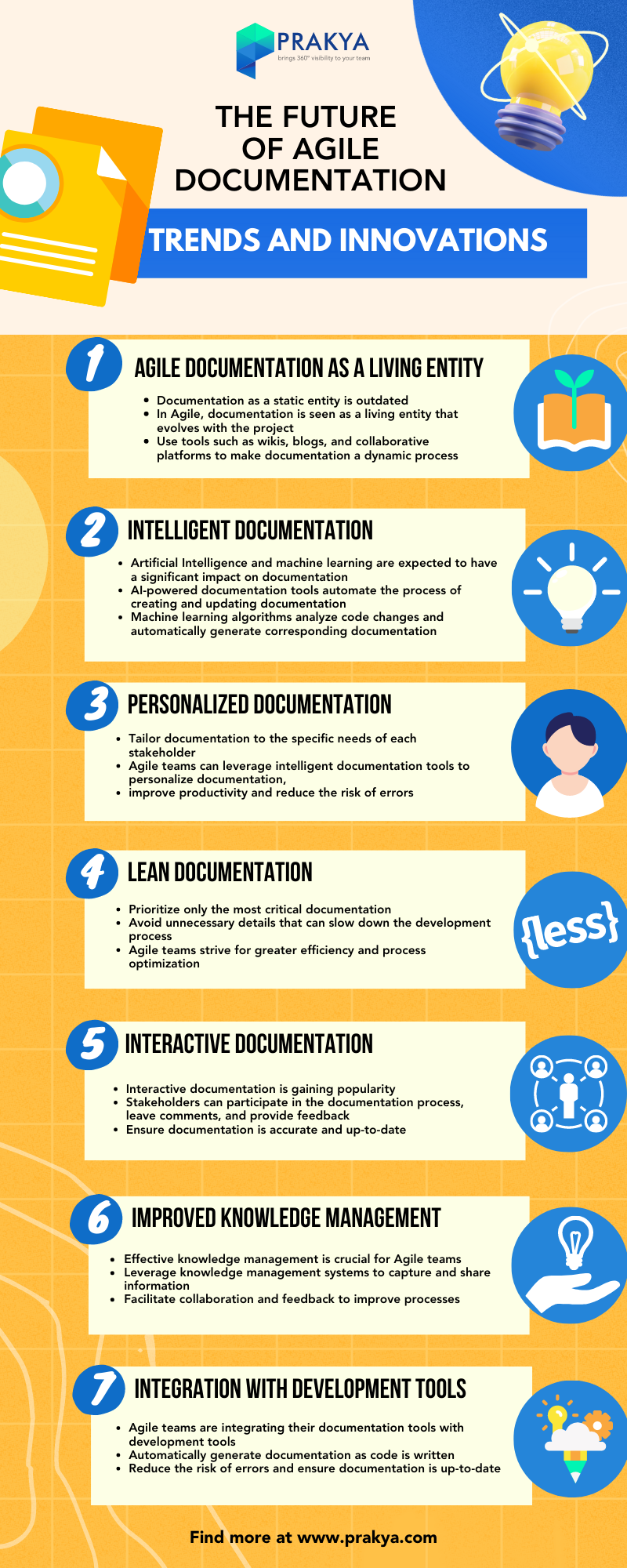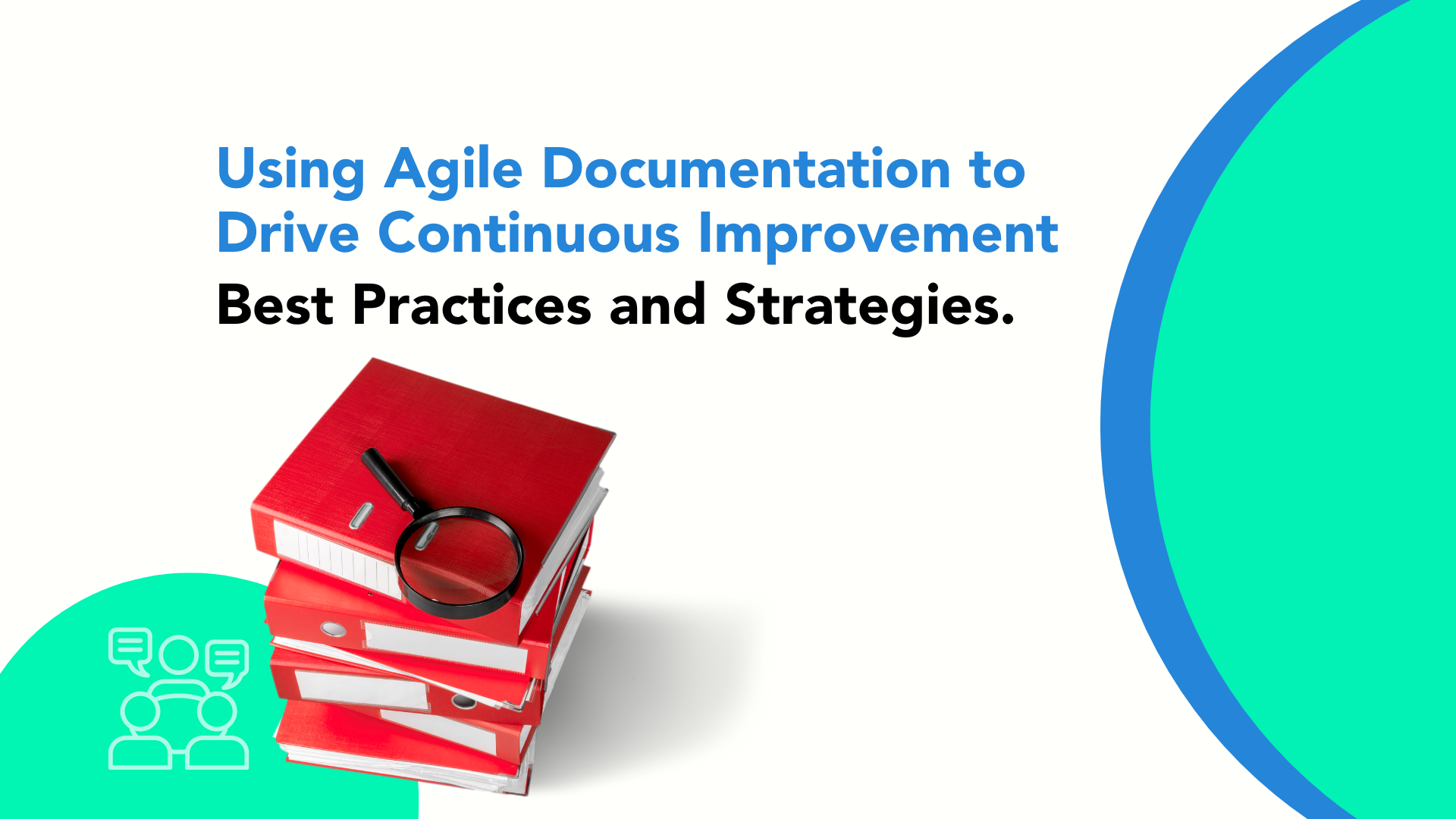What is Agile Documentation, and why is it so important?
To put it simply, Agile Documentation is the process of creating and maintaining documentation in an Agile development environment.
But how is it different from traditional technical documentation, and why should we care?
Unlike technical documentation, which can often be time-consuming and difficult to maintain, Agile Documentation is designed to be lean, flexible, and responsive to change. It focuses on providing just enough information to support effective communication and collaboration between team members and stakeholders, without bogging down the development process.
Agile Documentation is critical in driving continuous improvement in Agile methodology. By capturing and sharing knowledge throughout the development process, teams can identify areas for improvement and refine their processes over time. This leads to better outcomes, improved quality, and increased customer satisfaction.
But don’t just take our word for it. The Agile Manifesto itself emphasizes the importance of working software over comprehensive documentation. By prioritizing collaboration and face-to-face communication, Agile teams can create documentation that adds value without sacrificing speed or agility.
The Evolution of Agile Documentation
Documentation was often an afterthought in the early days of Agile development. The focus was on delivering working software quickly, with little regard for written documentation. However, over time, Agile teams realized that documentation played a critical role in effective communication and collaboration.
When done right, Agile documentation adds value by providing necessary information for team members, stakeholders, and end-users. It can take many forms, including user stories, process flows, wireframes, and acceptance criteria, among others.
Integrating Agile documentation into the development process has many benefits. It facilitates better communication, collaboration, and knowledge sharing among team members. It helps to ensure that everyone is working towards the same goals and has a clear understanding of project requirements. It also provides a means for continuous improvement, allowing teams to learn from past successes and failures and make necessary changes along the way.
For example, in an Agile software development project, a team might use user stories as a form of documentation. These user stories capture the end-users’ requirements and help the team to understand what they need to build. During development, the team can reference the user stories to ensure they are meeting the requirements. After the software is deployed, the user stories can serve as a reference point for any future enhancements or changes.
Best Practices for Creating Agile Documentation that Adds Value
Not all documentation is created equal, and creates effective Agile Documentation requires a certain set of best practices. Here are some key practices for creating Agile Documentation that adds value to the development process.
The Art of Just Enough
- One of the fundamental principles of Agile Documentation is “just enough” documentation. This means providing the necessary information without overwhelming the reader with unnecessary details.
- The goal is to provide documentation that is concise, clear, and easily digestible. The Agile approach to documentation prioritizes the information that is most relevant to the audience and avoids information overload.
- For example, instead of providing a lengthy document outlining every possible scenario for a feature, Agile Documentation might provide a simple user story that highlights the most critical aspects of the feature.
- This approach ensures that the documentation is accessible to all team members, regardless of their technical expertise, and helps to promote collaboration and understanding.
Writing for Understanding and Usefulness
- Agile Documentation should be written with the audience in mind. This means using language that is clear, concise, and accessible to all team members.
- Documentation that is overly technical or written in jargon can create confusion and hinder the development process.
- To ensure that Agile Documentation is useful to the intended audience, it’s essential to understand their needs and perspective.
- Documentation should be written from the user’s point of view, with a focus on what they need to know to complete their tasks effectively.
Capturing Essential Information While Avoiding Overload
- It’s essential to capture the essential information without overwhelming the reader with details that aren’t relevant.
- The key is to provide enough information to support the development process while avoiding unnecessary details that can lead to confusion and misinterpretation.
- One way to achieve this balance is to use visual aids, such as diagrams and flowcharts, to present information in a clear and concise way. These visual aids can help to communicate complex information quickly and effectively.
The Role of Collaboration and Feedback in Agile Documentation
- Collaboration and feedback are essential components of the Agile development process, and the same holds for Agile Documentation. Documentation should be viewed as a collaborative effort, with input from all team members.
- This approach ensures that the documentation is accurate, relevant, and useful to all team members.
- Feedback is also critical in Agile Documentation. Team members should be encouraged to provide feedback on the documentation regularly. It can help to identify areas where the documentation can be improved and ensure that it remains relevant and useful as the development process progresses.
Strategies for Using Agile Documentation to Drive Continuous Improvement
Agile documentation can be a powerful tool for driving continuous improvement and optimizing processes. Here are some strategies for using Agile documentation to achieve these goals:
Leveraging Agile Methodology for Process Optimization
Agile methodology emphasizes iterative development and continuous improvement. By using Agile documentation to capture information about each iteration, teams can more easily identify areas for improvement and adjust their processes accordingly. This can help them optimize their workflow and deliver better results.
Managing Change with Agile Documentation
Change is a constant in the software development process. Agile documentation can help teams manage change by providing a central repository of information that everyone can access and update as needed. This can help ensure that everyone is on the same page and that changes are implemented smoothly and efficiently.
Utilizing Knowledge Management Practices to Improve Organizational Learning
Agile documentation can also be used to facilitate organizational learning. By capturing knowledge about each project and iteration, teams can build up a library of best practices and lessons learned that can be shared and reused across the organization. This can help improve overall quality and efficiency.
The Importance of Iterative Development and Continuous Feedback
Agile documentation should be an ongoing process that evolves with each iteration. Teams should be encouraged to provide feedback and make suggestions for improvement. By using Agile documentation to capture and act on this feedback, teams can ensure that they are continuously improving and delivering better results.
The Future of Agile Documentation: Trends and Innovations
Here are some of the latest trends and innovations in Agile documentation and their impact on the development process.
Agile Documentation as a Living Entity
Traditionally, documentation has been viewed as a static entity that is created once and then left untouched. However, in Agile, documentation is seen as a living entity that evolves with the project.
This approach allows teams to create documentation that is up-to-date and relevant to the current state of the project. To achieve this, teams can use tools such as wikis, blogs, and other collaborative platforms to make documentation a dynamic process.
Intelligent Documentation
The increasing use of artificial intelligence and machine learning is expected to have a significant impact on documentation in the future. With AI-powered documentation tools, teams can automate the process of creating and updating documentation.
For instance, using machine learning algorithms, these tools can analyze code changes and automatically generate corresponding documentation. This innovation is expected to save time and improve the accuracy of documentation.
Personalized Documentation
As the importance of documentation increases, it is becoming necessary to tailor documentation to the specific needs of each stakeholder. Personalized documentation allows developers to easily find the information they need, improving productivity and reducing the risk of errors. Agile teams can leverage intelligent documentation tools to personalize documentation for different stakeholders, such as developers, testers, and product owners.
Lean Documentation
Agile development emphasizes the importance of delivering working software over comprehensive documentation.
Lean documentation takes this approach further by prioritizing only the most critical documentation, avoiding unnecessary details that can slow down the development process. This trend is expected to continue as Agile teams strive for greater efficiency and process optimization.
Interactive Documentation
Interactive documentation is a trend that is gaining popularity as Agile teams seek to improve collaboration and knowledge sharing. With interactive documentation, stakeholders can participate in the documentation process, leave comments, and provide feedback.
This approach ensures that documentation is accurate and up-to-date, as stakeholders can contribute their knowledge and expertise.
Improved Knowledge Management
Effective knowledge management is crucial for Agile teams to achieve continuous improvement. Agile teams can leverage knowledge management systems to capture and share information, ensuring that documentation is available when it is needed.
These systems can also facilitate collaboration and feedback, allowing teams to learn from each other and improve their processes.
Integration with Development Tools
To improve efficiency and reduce manual effort, Agile teams are integrating their documentation tools with their development tools. This approach allows developers to automatically generate documentation as they write code, reducing the risk of errors and ensuring that documentation is up-to-date. This trend is expected to continue as Agile teams seek to optimize their processes and achieve greater efficiency.

Wrapping up , as Agile methodologies continue to evolve, documentation is also changing to support the development process. Agile documentation is becoming more dynamic, intelligent, personalized, lean, interactive, and integrated. These trends and innovations are expected to improve collaboration, knowledge sharing, and efficiency, allowing Agile teams to deliver high-quality software at a faster pace.





